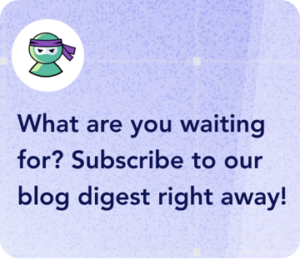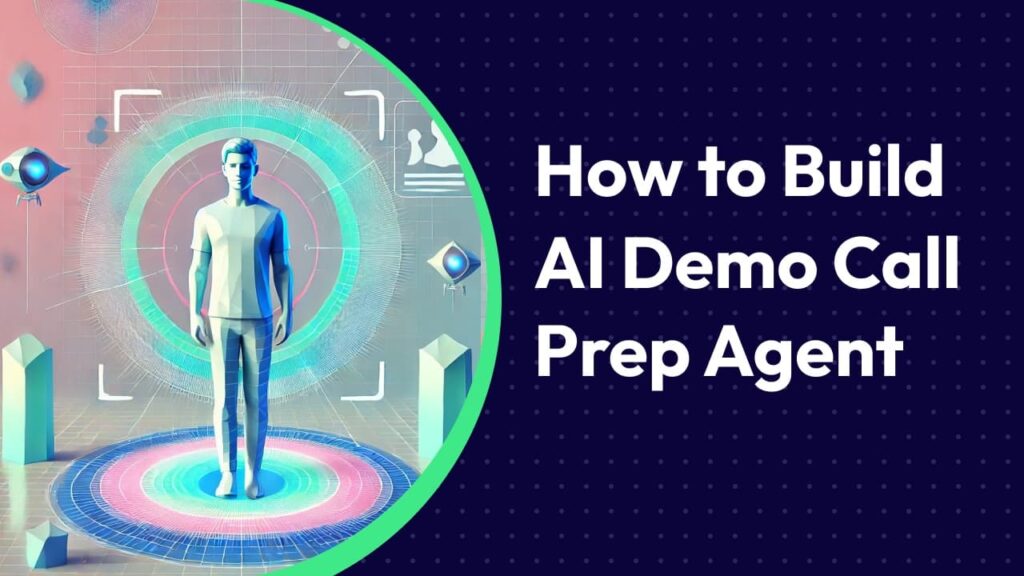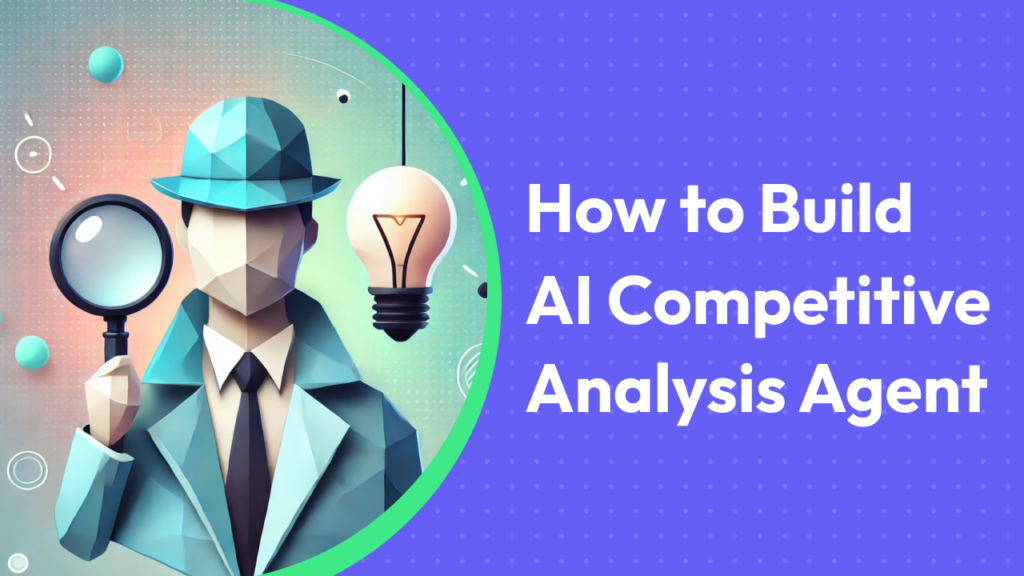- Why SEO Teams Need to Automate Meta Description Audits
- Step 1: Begin Your AI Journey
- Step 2: Define Your Agent’s Goal
- Step 3: Choose Your Integration Needs
- Step 4: Set Up Your Data Access
- Step 5: Choose Your Interaction Channel
- Step 6: Define the Agent Workflow
- Step 7: Choose Your Tools & Services
- Step 8: Add Knowledge Sources
- Step 9: Workflow Generation
- Step 10: Final Configuration and Launch
Why SEO Teams Need to Automate Meta Description Audits
SEO is a game of details, and meta descriptions are some of the smallest, but one of the most powerful, pieces of the puzzle. A well-crafted meta description doesn’t just improve your search rankings—it directly influences your click-through rate (CTR). However, keeping track of thousands of pages and ensuring every meta description is optimized can feel like an endless task.
Did you know that over 50% of pages on the web have missing or poorly optimized meta descriptions? That’s a huge opportunity missed for increasing organic traffic (Moz, 2023). Manually auditing meta descriptions across a site can take hours—especially on larger sites.
But what if you could automate this entire process, ensuring that every page on your website is up to SEO standards with just a few clicks? Enter the Meta Description Auditor Agent. In this tutorial, we’ll walk you through creating an AI-powered tool that automatically scans your website, identifies missing or problematic meta descriptions, and provides actionable recommendations for optimization—all while saving your SEO team precious time.
Ready to supercharge your meta description audits? Let’s dive in!
Step 1: Begin Your AI Journey
Sign up or log in to Omnimind.ai and start creating your first AI Agent! Click on the “Get Started” button in the Create AI Agent section.
Step 2: Define Your Agent’s Goal
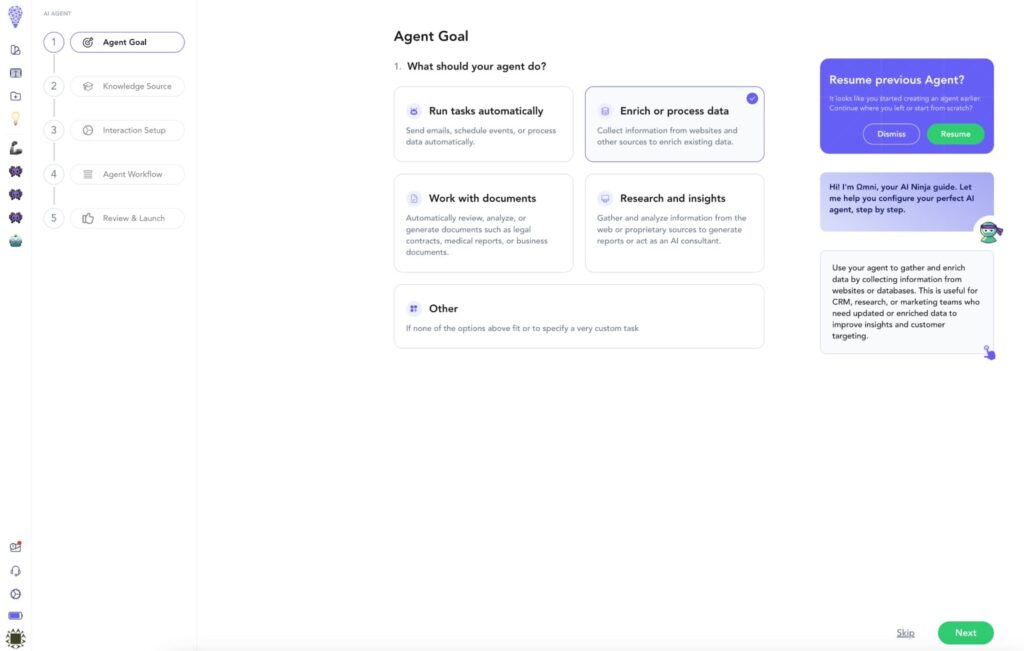
For your Meta Description Auditor Agent, select “Answer with knowledge” as your agent’s primary goal. This option is perfect for creating a comprehensive SEO audit tool because it will:
- Help SEO teams identify pages with missing or problematic meta descriptions
- Automatically scan websites to find indexed pages across different sections
- Analyze meta descriptions for optimal length, relevance, and keyword usage
- Provide detailed recommendations to improve search appearance and click-through rates
Step 3: Choose Your Integration Needs
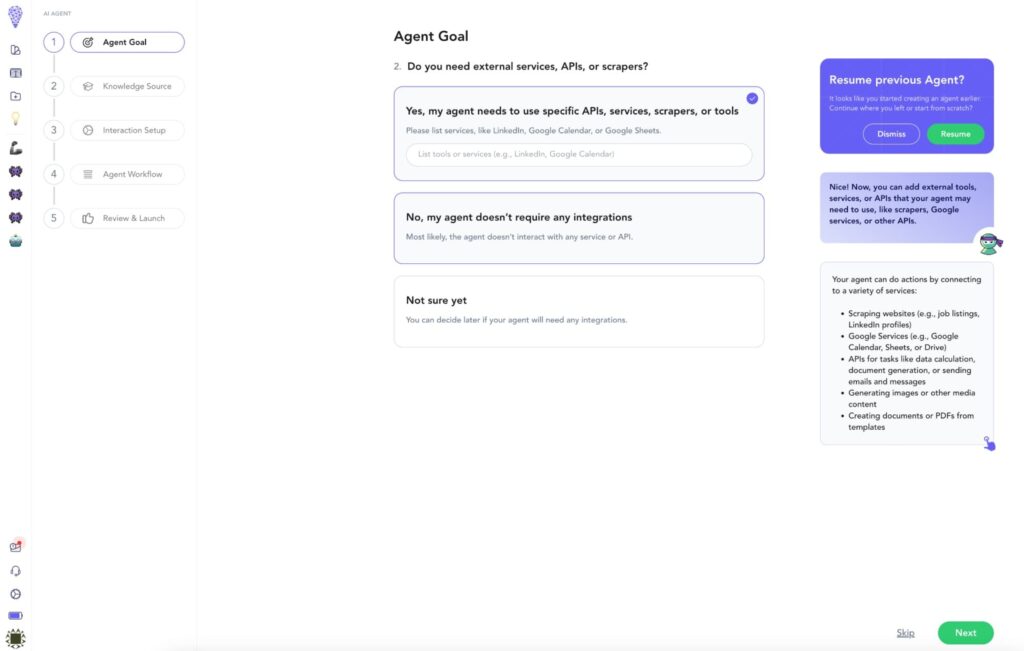
For your Meta Description Auditor Agent, select “Yes, my agent needs to use specific APIs, services, scrapers, or tools” when asked about integrations.
This option is essential because your agent will need to connect with multiple services to gather comprehensive website information. The specific tools will be selected in Step 7, but for now, we’re simply indicating that your agent will require external integrations.
Click “Next” to continue setting up your agent.
Step 4: Set Up Your Data Access
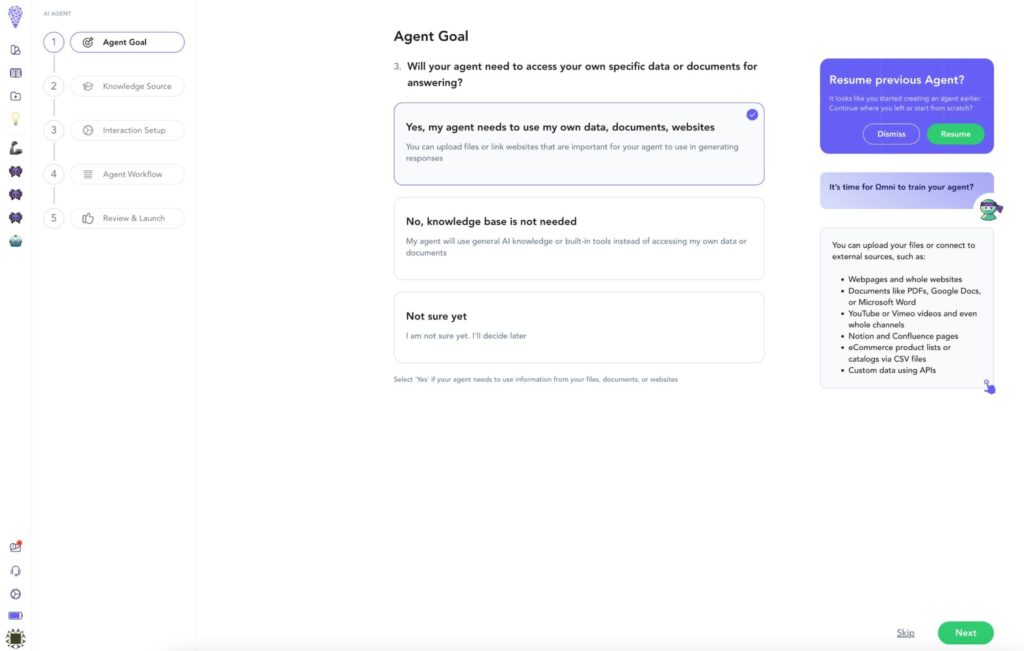
Empower your AI with comprehensive data access capabilities:
- Website pages and structures
- Meta description tags
- Page titles and heading elements
- URL patterns and site architecture
- SEO best practices
- Industry-specific optimization guidelines
Step 5: Choose Your Interaction Channel
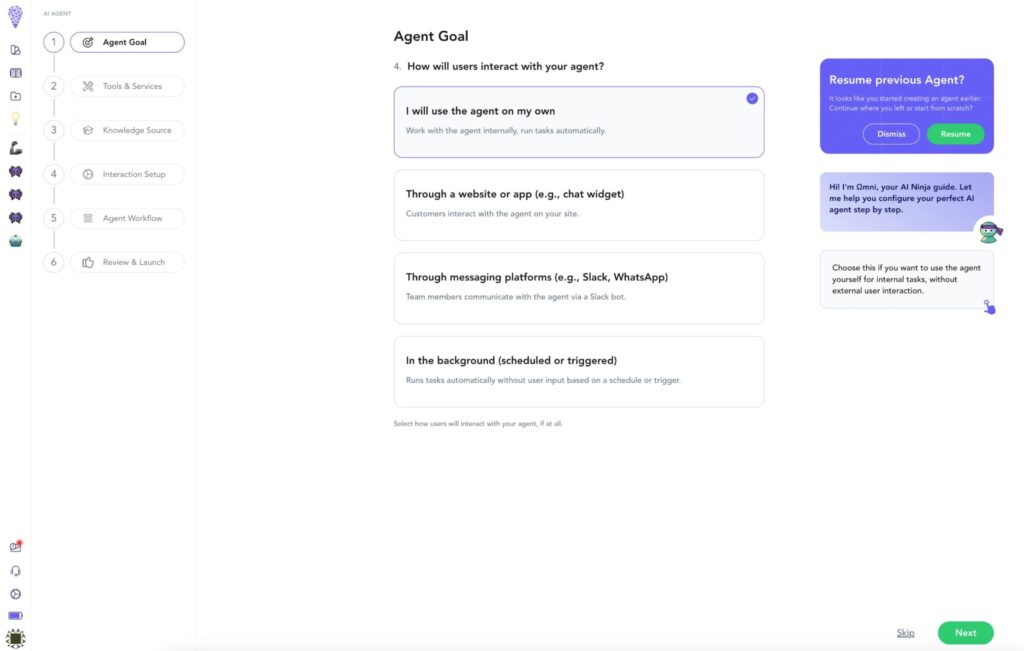
Get direct access to all your analysis in real time via the chatbot, choose “I will use the agent on my own”:
- Seamless chat interface
- Multi-device functionality
- Instant SEO insights
- Comprehensive audit reports
- Actionable recommendations
Wait for Omnimind to craft the perfect AI Agent for you!
Step 6: Define the Agent Workflow
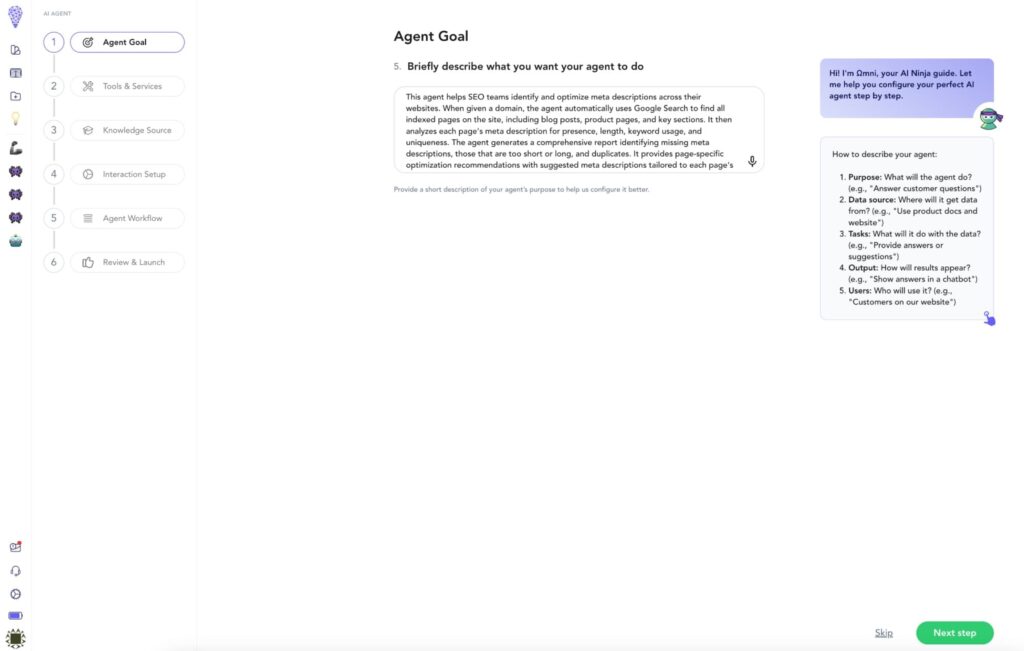
In this step, you’ll need to provide a clear description of how your Meta Description Auditor Agent should work. This helps Omnimind craft the perfect workflow for your agent.
Enter a description like this:
“This agent helps SEO teams identify and optimize meta descriptions across their websites. When given a domain, the agent automatically uses Google Search to find all indexed pages on the site, including blog posts, product pages, and key sections. It then analyzes each page’s meta description for presence, length, keyword usage, and uniqueness. The agent generates a comprehensive report identifying missing meta descriptions, those that are too short or long, and duplicates. It provides page-specific optimization recommendations with suggested meta descriptions tailored to each page’s content. This saves hours of manual auditing and ensures websites have properly optimized meta descriptions for better search visibility and click-through rates.”
This simple explanation tells Omnimind exactly what your agent needs to do without technical jargon or complex formatting. It covers the trigger mechanism, research process, and expected output in straightforward language.
Click “Next” after entering your description to continue setting up your agent.
Step 7: Choose Your Tools & Services
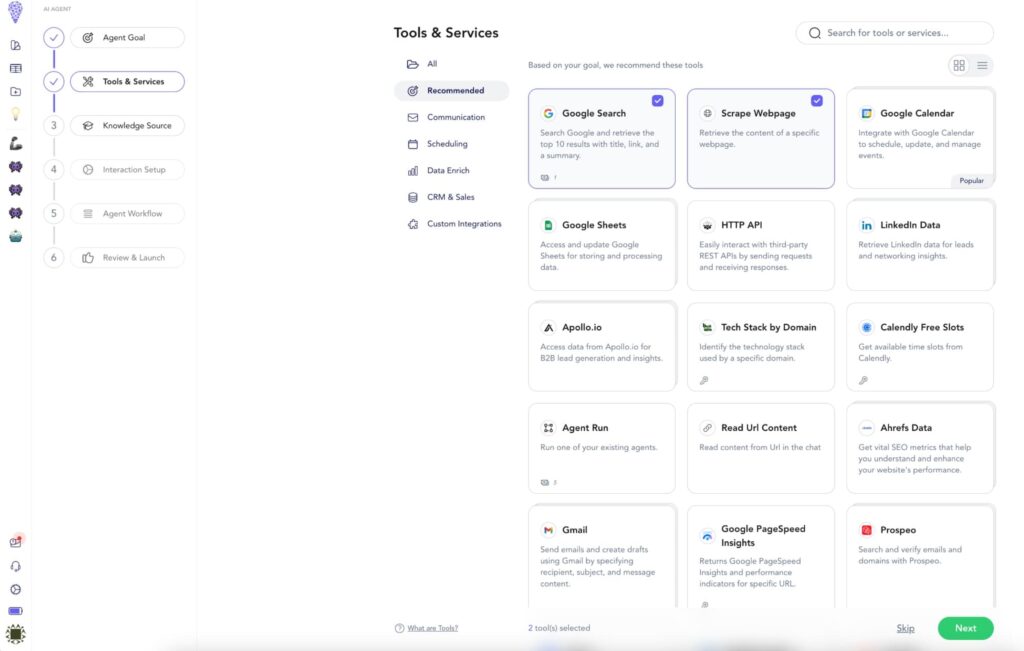
Now it’s time to select the specific tools your Meta Description Auditor Agent will use. This is a critical step that defines your agent’s capabilities. From the available tools, select these essential ones:
Google Search: This powerful tool helps your agent find all indexed pages on the target website. It performs specialized searches using site: operators and URL patterns to locate homepage, blog posts, product pages, and other important sections.
Scrape Webpage: This tool analyzes each identified page to extract meta descriptions, page titles, and content. It can identify missing tags, measure character lengths, and extract context to suggest optimized descriptions.
AI Model Configuration: This tool helps generate tailored meta description recommendations based on page content and industry best practices. It ensures suggestions are the right length, include relevant keywords, and align with each page’s purpose. Feel free to choose your favorite AI Model, (ChatGPT, Anthropic, Llama, etc.)
The entire process happens automatically when triggered by a domain audit request.
Select each tool by clicking on them, then click “Next” to continue building your Meta Description Auditor agent.
Step 8: Add Knowledge Sources
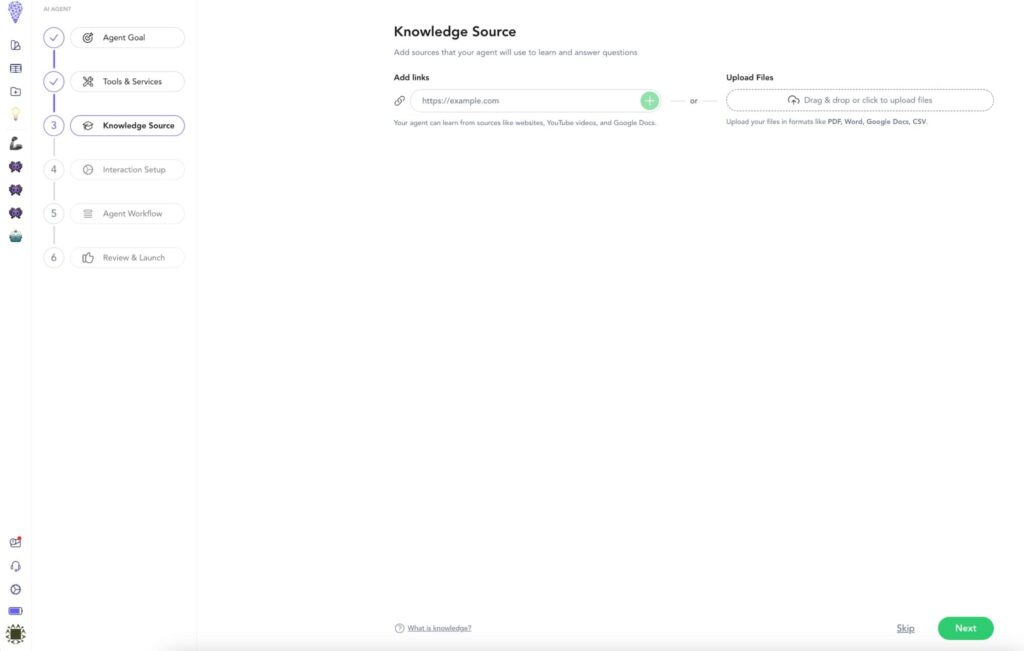
In this step, provide your AI agent with the knowledge it needs to perform effective meta description audits. You can upload valuable resources such as:
- SEO best practices documents
- Meta description optimization guides
- Industry-specific keyword research
- Click-through rate studies
- Search snippet length guidelines
These resources help your agent understand:
- How to identify relevant keywords for different page types
- Which meta description formats drive higher click-through rates
- How to optimize descriptions for different industries
- What common meta description issues to look for
- How to prioritize fixes by SEO impact
Click “Next step” to continue building your Meta Description Auditor agent.
Step 9: Workflow Generation
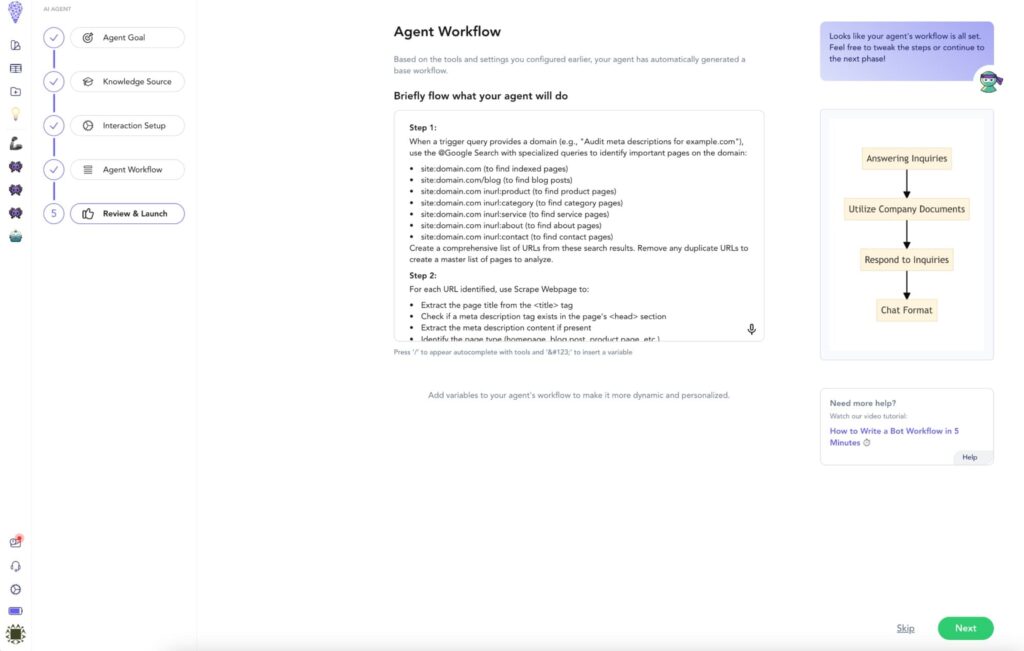
Omnimind will generate a sample workflow for your agent. To fully utilize the AI agent, we recommend using this workflow.
The workflow will include steps like:
- Receiving a domain to audit
- Using Google Search to find all indexed pages
- Scraping each page to analyze meta description status
- Identifying missing or problematic meta descriptions
- Generating optimized recommendations
- Creating a comprehensive audit report with tables
- Prioritizing fixes by SEO impact
If you run into any issues with the generated workflow, here is our recommended workflow for this Agent:
## Step 1:
When a trigger query provides a domain (e.g., “Audit meta descriptions for example.com”), use Google Search with specialized queries to identify important pages on the domain:
– site:domain.com (to find indexed pages)
– site:domain.com/blog (to find blog posts)
– site:domain.com inurl:product (to find product pages)
– site:domain.com inurl:category (to find category pages)
– site:domain.com inurl:service (to find service pages)
– site:domain.com inurl:about (to find about pages)
– site:domain.com inurl:contact (to find contact pages)
Create a comprehensive list of URLs from these search results. Remove any duplicate URLs to create a master list of pages to analyze.
## Step 2:
For each URL identified, use Scrape Webpage to:
– Extract the page title from the <title> tag
– Check if a meta description tag exists in the page’s <head> section
– Extract the meta description content if present
– Identify the page type (homepage, blog post, product page, etc.)
– Extract h1 headings and primary content to understand page context
– Identify if canonical tags are present (to avoid reporting on duplicate content pages)
## Step 3:
Analyze each meta description and title to identify:
– Missing meta descriptions
– Meta descriptions that are too short (less than 70 characters)
– Meta descriptions that are too long (more than 160 characters)
– Duplicate meta descriptions across different pages
– Meta descriptions that don’t include primary keywords
– Titles that are too short or too long (optimal is 50-60 characters)
– Misalignment between title, meta description, and page content
## Step 4:
Generate a comprehensive meta description audit report that includes:
1. Executive summary showing:
– Total pages checked
– Number of pages missing meta descriptions
– Number of pages with duplicate meta descriptions
– Number of pages with meta descriptions that are too short/long
– Overall SEO impact assessment
2. Detailed findings organized in tables by page type:
| Page Type | URL | Page Title | Meta Description | Status | Character Count |
|———–|—–|————|——————|——–|—————-|
| Homepage | example.com | Example Site | We provide… | Missing | 0 |
| Blog Post | example.com/blog/post | Blog Title | Short description | Too Short | 45 |
3. Optimization recommendations table:
| URL | Current Title | Current Meta Description | Optimized Title | Optimized Meta Description | Primary Keywords |
|—–|————–|————————–|—————–|—————————-|—————–|
| example.com | Example Site | None | Improved Title | Suggested meta description… | keyword1, keyword2 |
| example.com/blog | Blog | Short… | Better Blog Title | Enhanced meta description… | keyword3, keyword4 |
4. Prioritized list of pages needing attention:
– High-priority pages (homepage, main navigation, high-traffic pages)
– Medium-priority pages (blog posts, secondary navigation)
– Low-priority pages (archive pages, tag pages, etc.)
For each page needing optimization, provide specific recommendations tailored to the page content and purpose.
Step 10: Final Configuration and Launch
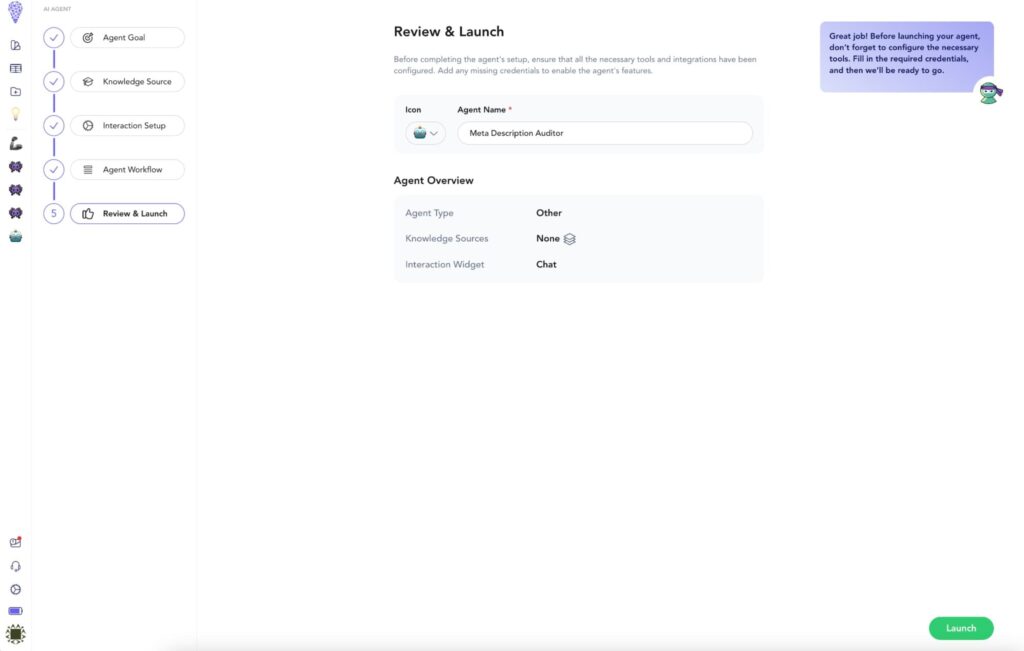
We’re at the last step!
Final Touches:
- Name your AI Agent: Choose an icon that represents SEO Auditing
- Name your bot “Meta Description Auditor” or something relevant so you could easily find it
Configure Your Selected Tools:
- Google Search Settings
- Webpage Scraper configuration
- AI Prompt preferences
- Google Docs Template format
Review Your Complete Setup:
✅ Agent Type: Meta Description Auditor
✅ Tools Connected: Google Search, Webpage Scraper, AI Prompt, Google Docs Template
✅ Knowledge Sources: SEO resources and best practices
✅ Interaction Widget: Chat interface
✅ Activation: Triggered by domain audit requests
Once everything is configured, hit the “Launch” button, and your AI Meta Description Auditor will be ready to transform hours of manual SEO auditing into seconds of actionable insights!
Congratulations! You’ve now built an AI-powered Meta Description Auditor Agent that will transform the way you approach SEO audits. No more manually searching for missing descriptions or worrying about character counts. Your agent will now automatically scan your entire site, pinpoint issues, and deliver tailored recommendations—all in seconds.

How useful was this post?
Click on a star to rate it!
Average rating 0 / 5. Vote count: 0
No votes so far! Be the first to rate this post.

